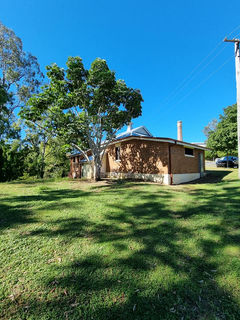

There Was Once an Asylum



This site not only provides an overview of mental health history and its implications for Goodna, but also explores the complex relationship between memory and history
There are stories we may never know, but this site uncovers the history, revealing the layers of understanding that form the foundation of the present.
It is done in a way that honours the patients, clients, and the people.
Morgue
Built in 1902, extended in 1949
The Morgue stands to the northwest of the Powerhouse. Purpose-built as a morgue in 1902 for the hospital and extended and remodelled in 1949 to increase capacity and incorporate refrigeration, it retains its functional mortuary layout and fixtures.
In 2020, the building is vacant and is highly intact.
Features of the Morgue of state-level cultural heritage significance also include
-
Form, scale and materials: small, one-storey brick building on brick foundations with concrete floor; main morgue building with Dutch-gable roof, roof fleche (off-centre location reflecting extended building form) and vented gablets; brick garage with skillion roof attached to the southwest end; flat-sheeted lean-to with skillion roof attached to northwest side; roofs clad in corrugated metal; timber boarded eaves; metal water goods; face brick exterior walls; exterior openings with concrete lintels and sills; painted brick interior walls
-
Layout: The main morgue building contains waiting and viewing rooms at its southwest end, a central coffin store and refrigerator room with a loading area, and its autopsy, scrub and change rooms at its northeast end; three separate entrances along the front (southeast) side access the garage, waiting room and coffin store loading area, with stairs and a side entrance to the change room
-
Joinery: original slimline corrugated metal ceilings (1902); early sheet-and-batten-lined ceilings (1949) with moulded cornices; timber boarded exterior doors; wide interior doorways; low-waisted (original) and high-waisted (extended and remodelled areas) interior doors
-
Details associated with light and ventilation: ceiling vents, decorative roof fleche and vented gablets; large openings on the northeast and southeast sides, with adjustable glass louvres; fly screens to vent, door and window openings
-
Details associated with room functions: waiting room: exterior entrance (widened 1949) comprising part-glazed single door, with glass louvre fanlight and sidelights; early light fitting with glass shade : viewing room: wide interior doorways accessing waiting and coffin storage rooms : coffin store and refrigerator: exterior entrance with double door; refrigerated body store with brick walls, insulated metal doors, and interior metal trays on rollers; open-fronted coffin store above with timber-framed and -battened shelves; wide interior doorways accessing autopsy and viewing rooms : autopsy room: tiled wall finish; early electrical fittings; double-door opening to loading room with louvred fanlight; concrete floor with perimeter drain; free-standing metal autopsy table with sink and drainage channels : scrub-up room, change room and toilet: exterior entrance to change room with outer boarded door and inner screen door; timber storage cupboards, metal sink in scrub-up room : garage: exterior entrance with arched head and double doors; hospital gurney stored in garage
-
Open concrete parking area and path; brick and concrete stairs with metal balustrade at the northeast end.






